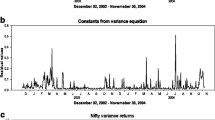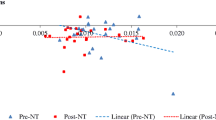Abstract
This research examines the impact of local and international market factors on the pricing of stock indexes futures in East Asian countries. The purpose of this paper is to present a study of the significant factors that determine the major stock indexes futures’ prices of Hong Kong, Malaysia, Singapore, South Korea and Taiwan. This study first investigates the relationships between Hang Seng Index Futures, KLCI Futures, SiMSCI Futures, KOSPI Futures, Taiwan Exchange Index Futures and local interest rates, dividend yields, local exchange rates, overnight S&P500 index and a newly constructed index, Asian Tigers Malaysia Index (ATMI). 11 years historical data of stock indexes futures and the economic statistics are studied; 10 years in-sample data are used for testing and developing the pricing models, and 1 year out-of-sample data is used for the purpose of verifying the predicted values of the stock indexes futures. Using simple linear regressions, local interest rates, dividend yields, exchange rates, overnight S&P500 and ATMI are found to have significant impact on these futures contracts. In this research, the next period close is predicted using simple linear regression and non-linear artificial neural network (ANN). An examination of the prediction results using nonlinear autoregressive ANN with exogenous inputs (NARX) shows significant abnormal returns above the passive threshold buy and hold market returns and also above the profits of simple linear regression (SLR). The empirical evidence of this research suggests that economic statistics contain information which can be extracted using a hybrid SLR and NARX trading model to predict futures prices with some degree of confidence for a year forward. This justifies further research and development of pricing models using fundamentally significant economic determinants to predict futures prices.





Similar content being viewed by others
Notes
Levenberg-Marquadrt Function for use with Matlab [Internet]. MathWorks. 2014 can be found on http://www.mathworks.com/help/nnet/ref/trainlm.html.
It is estimated that the mean transaction cost for financial and commodity futures ranges from 0.0004 to 0.033% of the nominal value per contract for each round-trip trade (Locke and Venkatesh 1997). Szakmary and Sharma (2010) treat transactions costs as a percent of contract value and use the rate of 0.05% per side easily encompasses ‘all in’ transaction cost based on the percent of transaction (contract value). Due to the tough competition in the futures brokerage business, the rate charged for customers vary greatly and it is not likely to track the exact variations from the past (Szakmary and Sharma 2010) This rate is much higher than what is reported in Locke and Venkatesh 1997 as we presumed it inclusive of all exchange fees, clearing fees, and broker’s commission.
References
Atsalakis GS, Valavanis KP (2009) Surveying stock market forecasting techniques—part II: soft computing methods. Expert Syst Appl 36(3):5932–6594
Chan Phooi M’ng J, Mehralizadeh M (2016) Forecasting east asian indices futures via a novel hybrid of wavelet-PCA denoising and artificial neural network models. PLoS ONE 11(6):e0156338. https://doi.org/10.1371/journal.pone.0156338
Chen S (2012) The predictability of aggregate Japanese stock returns: implications of dividend yield. Int Rev Econ Finance 22(1):284–304
Chen Y, Tsai W (2017) Determinants of price discovery in the VIX futures market. J Empir Finance 43:59–73
Chen N, Roll R, Ross RA (1986) Economic forces and the stock market. J Bus 59(3):383–403
Cornell B, French RK (1983) The pricing of stock index futures. J Futur Mark 3(1):1–14
Dempster M, Medova E, Tang KE (2012) Determinants of oil futures prices and convenience yields. Quant Finance 12:1795–1809
Fama EF (1965) Random walks in stock market prices. Financ Anal J 21(5):55–59
Fernandex-Rodriquez F, Gonzalez-Martel C, Sosvilla-Rivero S (2000) On the profitability of technical trading rules based on artificial neural networks: evidence for the Madrid stock market. Econ Lett 69:89–94
Frino A, Hill A (2001) Intraday futures market behavior around major scheduled macroeconomic announcements: Australian evidence. J Bank Finance 25(7):1319–1337
Fung AK, Mok DM, Lam K (2000) Intraday price reversals for index futures in the US and Hong Kong. J Bank Finance 24:1179–1201
Fung AKW, Lam K, Lam KM (2010) Do the prices of stock index futures in Asia overreact to US market returns? J Empir Finance 17(3):428–440
Gencay R, Stengos T (1998) Moving average rules, volume and the predictability of security returns with feedforward networks. J Forecast 17:401–414
Gould GJ (1988) Stock index futures: the arbitrage cycle and portfolio insurance. Financ Anal J 44(1):48–62
Granger CJ (1969) Investigating causal relations by econometric models and cross-spectral methods. Econometrica 37(3):424–438
Guerard J (2010) Markowitz and the expanding definition of risk: applications of multi-factor risk models. In: Guerard J (ed) Handbook of portfolio construction: contemporary applications of markowitz techniques. Springer, Boston, pp 31–60
Guerard J, Markowitz H (2018) The existence and persistence of financial anomalies: What have you done for me lately? Financ Plann Rev 1:3–4
Guerard J, Xu G, Markowitz H (2020) A further analysis of robust regression modelling and data mining corrections testing in global stocks. Ann Oper Res. https://doi.org/10.1007/s10479-020-03521-y
Hamao Y, Masulis RW, Ng V (1990) Correlations in price changes and volatility across international stock markets. Rev Financ Stud 3:281–330
Hsing Y, Hsieh W (2012) Impacts of macroeconomic variables on the stock market index in Poland: new evidence. J Bus Econ Manag 13(2):334–343
Hsu H, Wang J (2004) Price expectation and the pricing of stock index futures. Rev Quant Financ Acc 23(2):167–184
Jo SK, Kim MJ, Lim K, Kim SY (2018) Correlation analysis of the Korean stock market: revisited to consider the influence of foreign exchange rate. Physica A 491:852–868
Kaastra I, Boyd M (1996) Designing a neural network for forecasting financial and economic timeseries. Neurocomputing 10:215–236
Kuan CM, Hornik K, White H (1994) A convergence result for learning in recurrent neural networks. Neural Comput 6:420–440
Lee CF (2020) Financial econometrics, mathematics, statistics and financial technology: an overall view. rev Quant Financ Acc 54(4):1529–1578. https://doi.org/10.1007/s11156-020-00883-z
Lee CF, Rui OM (2000) Does trading volume contain information to predict stock returns? Evidence from China’s stock markets. Rev Quant Financ Acc 14:341–360
Lee CF, Lee J, Lee A (2010) Handbook of quantitative finance and risk management. Springer, Boston, pp 1007–1024
Lee CF, Finnerty J, Lee J, Lee AC, Wort D (2012) Security analysis, portfolio management, and financial derivatives. World Scientific Publishing Co., Pte Ltd, Singapore
Lin WT, Tsai S, Lung P (2013) Investors’ Herd behavior: rational or irrational? Asia-Pacific J Financial Stud 42(5):755–776
Locke PR, Venkatesh PC (1997) Futures market transaction costs. J Futur Mark 17(2):229–245
Macaira P, Thomas A, Oliveira F, Ferrer A (2018) Time series analysis with explanatory variables: a systematic literature review. Environ Model Softw 107:199–209
MacKinlay AC, Ramaswamy K (1988) Index-futures arbitrage and the behavior of stock index futures Prices. Rev Financial Stud 1(2):137–158
Markowitz H (1952) Portfolio selection. J Finance 7(1):77–91. https://doi.org/10.1111/j.1540-6261.1952.tb01525.x
Merton RC (1973) An intertemporal capital asset pricing model. Econometrica 41(5):867–887
Miao H, Ramchander S, Zumwalt JK (2014) S&P 500 Index-futures price jumps and macroeconomic news. J Futur Mark 34(10):980–1001
Miyakoshi T (2003) Spillovers of stock return volatility to asian equity markets from Japan and the US. J Int Fin Mark, Inst Money 13(4):383–399
Restrepo-Echavarria P, Arias M (2017) Tigers, Cubs and Economic Growth. Federal Reserve Bank of St. Louis https//www.stlouisfed.org/on-the-economy/2017/may/tigers-tige-cubs-economic-growth. Accessed 25 May 2017
Roll R, Ross SA (1980) An empirical investigation of the arbitrage pricing theory. J Finance 35(5):1073–1103. https://doi.org/10.1111/j.1540-6261.1980.tb02197.x
Roope M, Zurbruegg R (2002) The intra-day price discovery process between the Singapore Exchange and Taiwan Futures Exchange. J Futu Markets: Futur, Options, Other Deriv Prod 22(3):219–240
Ross SA (1976) The arbitrage theory of capital asset pricing. J Econ Theory 13(3):341–360
Siegelmann HT, Horne BG, Giles CL (1997) Computational capabilities of recurrent NARX neural networks. IEEE Trans Syst Man Cybern B Cybern 27(2):208–215. https://doi.org/10.1109/3477.558801 (PMID:18255858)
Stoll HR, Whaley RE (1988) Volatility and futures: message versus messenger. J Portf Manag 14(2):20–22. https://doi.org/10.3925/jpm.1988.409144
Szakmary AC, Sharma SC (2010) Trend-following trading strategies in commodity Futures: a re-examination. J Bank Finance 34(2):409–426. https://doi.org/10.1016/j.jbankfin.2009.08.004
Thuraisamy KS, Sharma SS, Ahmed J (2013) The relationship between asian equity and commodity futures markets. J Asian Econ 28:67–75
White H (1989) Learning in artificial neural networks: a statistical perspective. Neural Comput 1(4):425–464. https://doi.org/10.1162/neco.1989.1.4.425
Yadao PK, Pope FP (1992) Intraweek and intraday seasonalities in stock market risk permia: cash and futures. J Bank Finance 16(1):233–270
Yao J, Chew L, Poh H (1999) Neural networks for technical analysis: a study on KLCI. Int J Theor Appl Fin 2(2):221–241
Zhang GP (2003) Time series forecasting using a hybrid ARIMA and neural network model. Neurocomputing 50:159–175
Zhang GP (2012) Neural networks for time-series forecasting. In: Rozenberg G, Bäck T, Kok JN (eds) Handbook of natural computing. Springer, Berlin, pp 461–477
Acknowledgements
The authors thank the anonymous reviewer for the sharp insights and observations on the initial paper which was an inferior reflection of this improved paper. The authors appreciate all the kind helpful comments made by the reviewer. The authors maintain that all lacking information are the authors’ weaknesses. The authors also wish to thank all who had given inputs to this research at the 13th NCTU Conference on January, 10, 2020 where the first draft of this paper was presented. The authors also wish to thank Kevin Ng and Foong Cheng Ho for helping us to prepare the slides and materials on this research for the 13th NCTU Conference.
Author information
Authors and Affiliations
Corresponding author
Additional information
Publisher's Note
Springer Nature remains neutral with regard to jurisdictional claims in published maps and institutional affiliations.
Appendices
Appendix 1
Correlations Analyses.
Appendix 2
Analysis of trading performance results.
Appendix 3
Percentage profitable of trading performance.
See Table 12.
Rights and permissions
About this article
Cite this article
Chan Phooi M’ng, J., Ham Yi Jer Do economic statistics contain information to predict stock indexes futures prices and returns? Evidence from Asian equity futures markets. Rev Quant Finan Acc 57, 1033–1060 (2021). https://doi.org/10.1007/s11156-021-00969-2
Accepted:
Published:
Issue Date:
DOI: https://doi.org/10.1007/s11156-021-00969-2
Keywords
- Algorithm trading model
- Artificial intelligence neural network
- Economic statistics
- Futures pricing model
- Stock indexes futures




